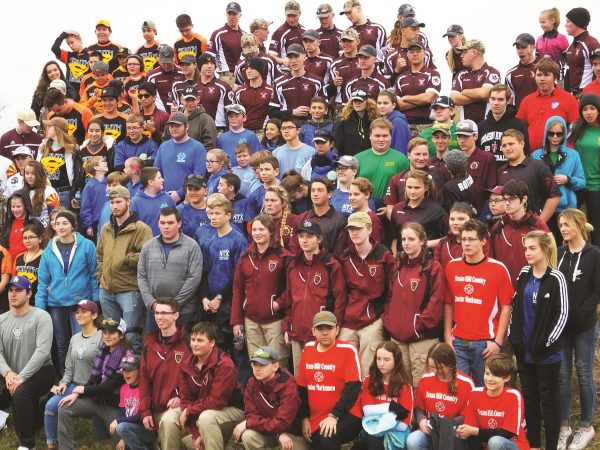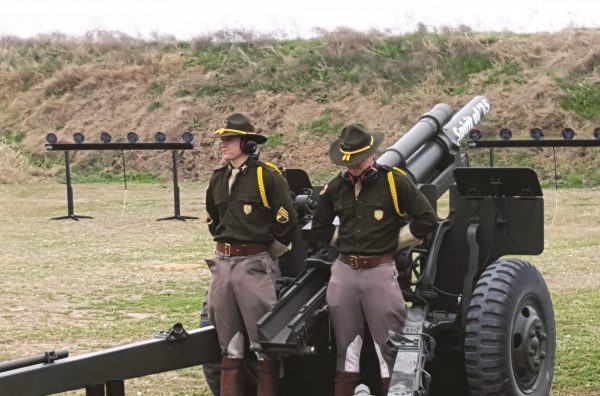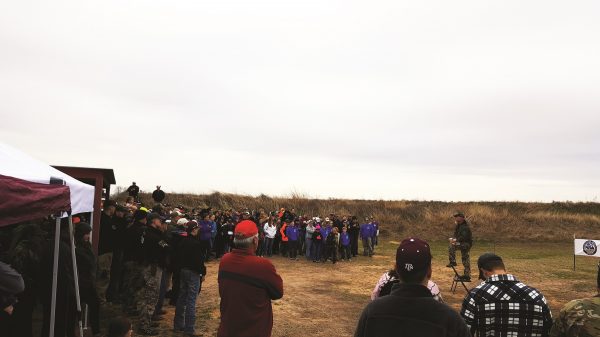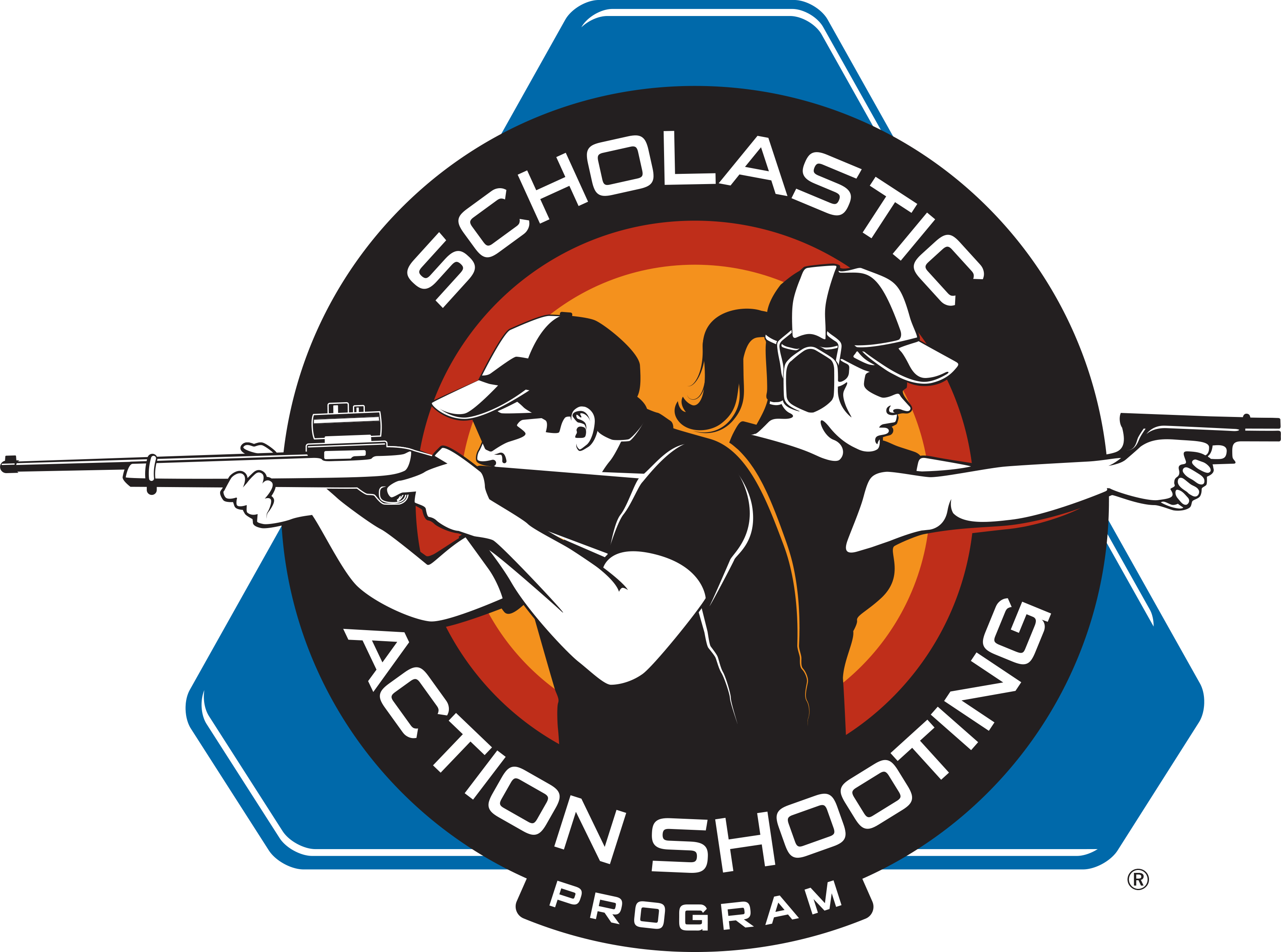Youth Teams Show How It’s Done in Texas
Reprinted with permission from Blue Press.
By Robin Taylor, www.taylorfreelance.com
Photos by Andre’ Dall’au, Jim Coffey
 BOOM!
BOOM!
The report jars your insides. Everyone knows a 105mm Howitzer is loud, but the wave of overpressure stuns mind and body. As you recover, you see the breech slam closed and the Section Chief’s sabre tip drops slowly.
BOOM!
The Texas A&M Corps of Cadets brings their field howitzer to ball games, ceremonial events, and once a year, to their own pistol shoot. The 2017 Scholastic Action Shooting Program (SASP) Southwest Regional has almost begun.
BOOM!
230 people cheer the last shot. Together with the gun, they’re shouting, “play ball!” in a distinctly gun-friendly way.
Here in Texas, just outside of College Station, youth teams from all over the West have traveled far to find out who’s the fastest. College students, cadets, high school, and middle school students alike shoot .22 pistols, 9mm service pistols, and just recently, .22 rifles in a fast-moving contest of speed and accuracy.
“This is the second-largest regional in the country,” says Rick Leach, SASP’s new director of development.
Rapid growth in Texas fueled by the Texas State Rifle Association Foundation (TSRAF) and the Texas A&M Corps of Cadets’ prestige has made the SW Regional one of the most popular regional events in the country. Teams from states as far away as Washington (a four-hour flight!) came to duke it out with not only the A&M Corps of Cadets (defending Collegiate National Champions) but also the South Texas juniors – the defending High School national champions. With 134 shooters on the line, the program’s growing strength and influence really showed.
“Last year we had 117 athletes in Texas,” says Leach. “So far this year, we’re at 150, and it’s early.”
He’s excited not just about the numbers, but about the demographic. At this year’s regional, 30% of the shooters were female.
“It’s the fastest-growing state in the nation right now,” says Leach.
Angela Gerlich, Executive Director of the TSRA Foundation brought together public financing, private financing, and successful local coaching to drive Texas SASP forward.
Under Mrs. Gerlich’s hand, discounted ammunition, steel target sets available for loan, expert coach trainers flown in from out of state, and above all the Texas Youth Action Shootout (TYAS) match series have all come about since August 2016.
To give you an idea of the panache shown by the Texas program, the night before the match, Texas A&M welcomed students to the military college’s Hall of Honor, showing off the history that propels the culture of A&M. A barbeque in the cadets’ dining hall (with the cadets present in full Class A uniform) added more prestige. The TSRAF and match sponsor Magpul made everyone welcome, setting the bar for hospitality very, very high!
According to Mrs. Gerlich, the Texas 4H program has more than 10,0000 students involved in the shooting sports. Most of that is shotgun, but handgun and rifle sports are coming on fast.
 As far as SASP goes, “the part I’m most proud of is how we’re recruiting using the A&M cadets and coaches to go out and work with our Texas youth that are interested in the SASP program. They are the most experienced group with the program in Texas and have really stepped up to help. These cadets are now able to continue their leadership training in a whole new way, and it’s working,” says Gerlich.
As far as SASP goes, “the part I’m most proud of is how we’re recruiting using the A&M cadets and coaches to go out and work with our Texas youth that are interested in the SASP program. They are the most experienced group with the program in Texas and have really stepped up to help. These cadets are now able to continue their leadership training in a whole new way, and it’s working,” says Gerlich.
On match day everyone has their game face on. Within a few minutes of the last cannon report, the distinct “ping-ping-ping” of gunfire on steel targets fills the air.
SASP courses closely resemble Steel Challenge – but no one uses a holster. Students start at low ready, then shoot five targets as fast as they can. Each shooter gets five runs on four sets of targets, discarding the slowest run. All told, the kids fire 100 rounds – plus any misses.
While the targets LOOK easy, the eye is deceived. It’s one thing to stand there and pot away at an 18X24” rectangle at 25 yards. When time is no object, the shots are easy, but once you get a timer out, everything changes.
“Go Fast” features four 18”X24” targets at just 7 yards, plus a 12” stop plate in the middle. Getting hits on the targets is easy – if you take your time. If you want to win, you’ve got to move. The fast guns shoot all five targets in under two seconds. The best ones shoot them in 1.5. That’s 1/3 second each, including a low-ready start!
“Focus” pushes the accuracy side, with small steel circles stashed as far back as 18 yards.
Walking around the range, clusters of kids wearing uniforms from their local gun clubs and schools smile and goof around. The adults are all business, discussing rules and herding their charges when needed, but the kids enjoy themselves at every turn.
Four-person teams get organized by equipment and age group. High School teams with .22s compete against other High School teams with .22s in “Senior Rimfire,” Middle School teams with 9mms compete in “Intermediate Centerfire.” Teams that don’t have enough of any one age group to make a team compete in “Open.”
Thanks to the support of the MidwayUSA Foundation donors (Larry Potterfield in particular), successful teams can win cash prizes that go into a special endowment to support the team. Most teams have relatively small endowments, but some successful fundraisers have pushed their endowments north of $250,000 – giving them more than $10,000 a year to help supply their athletes. State and private colleges have jumped in as well, offering scholarships to successful athletes and hiring coaches to lead college-level programs.
Yes folks, your kids can actually win a scholarship to shoot steel in college. The numbers are small, but you’ll see college recruiting stations at the SASP National Championship.
 The Corps of Cadets and South Texas came into the 2017 match as the favorites, expected to win the centerfire and rimfire contests. The Cadets won centerfire by forfeit, posting a strong 192-second combined time. (Anything faster than 200 seconds is nationally competitive, putting A&M in strong position for the College nationals in March.) In rimfire, the South Texas crew brought their top gun – none other than Ethan Inocando – a name that Blue Press readers have seen before. Inocando did not disappoint, winning the rimfire match with a blistering time of 35.32 seconds. Only a handful of athletes can break the 40-second mark. However, one athlete does not a make a winning 4-person team. Hot on his heels was “Team Gotta” captain Jake Overstreet, shooting a 36.89 for his team from Custer, Washington. Overstreet and his red-shirted teammates controlled the top of the leaderboard, posting a 179 second combined time. That was good enough to beat second-place South Texas’ score of 203. Team Gotta’s JV crew stumbled when ladies’ Middle School champion Naomi McKay’s Buckmark exploded in her hand, but McKay’s group won the JV contest anyway, shooting the second-fastest time in the match – a 186.
The Corps of Cadets and South Texas came into the 2017 match as the favorites, expected to win the centerfire and rimfire contests. The Cadets won centerfire by forfeit, posting a strong 192-second combined time. (Anything faster than 200 seconds is nationally competitive, putting A&M in strong position for the College nationals in March.) In rimfire, the South Texas crew brought their top gun – none other than Ethan Inocando – a name that Blue Press readers have seen before. Inocando did not disappoint, winning the rimfire match with a blistering time of 35.32 seconds. Only a handful of athletes can break the 40-second mark. However, one athlete does not a make a winning 4-person team. Hot on his heels was “Team Gotta” captain Jake Overstreet, shooting a 36.89 for his team from Custer, Washington. Overstreet and his red-shirted teammates controlled the top of the leaderboard, posting a 179 second combined time. That was good enough to beat second-place South Texas’ score of 203. Team Gotta’s JV crew stumbled when ladies’ Middle School champion Naomi McKay’s Buckmark exploded in her hand, but McKay’s group won the JV contest anyway, shooting the second-fastest time in the match – a 186.
SASP has started changing the dynamic for shooting sports in this country, making practical pistol into a scholarship-level sport. If you’d like to know more about the program, look them up at www.sssfonline.org
